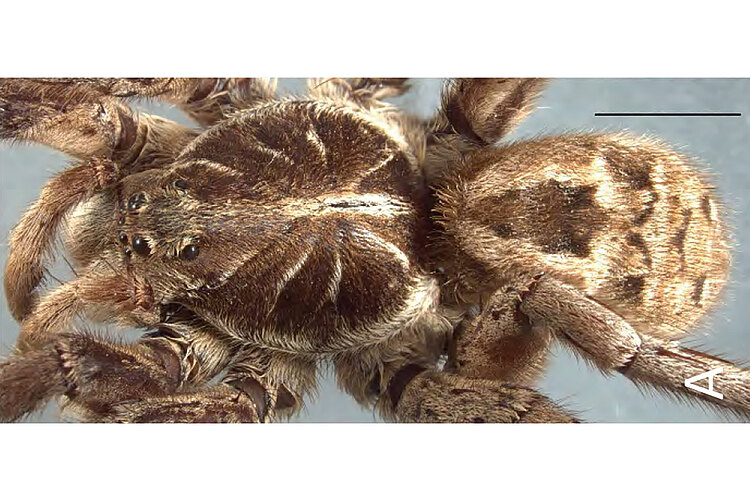Leuckart's Wolf Spider Tasmanicosa leuckartii (Thorell, 1870)
Fauna Portal species: 5358Diagnosis
(after Framenau & Baehr 2016): Tasmanicosa leuckartii is the only species in the genus which has a light patch of variable size in the centre of the venter. Genital morphology is similar to T. gilberta and T. fulgor. Males are most similar to T. gilberta, but can be distinguished by the shape of the terminal apophysis, which is broad and apically bent in T. gilberta, but twisted in T. leuckartii (that of T. fulgor is broadly sickle-shaped without apical modifications). Females are most similar to T. fulgor, but the epigyne is much shallower and overall narrower in T. leuckartii (that of T. gilberta has a much narrower median septum). Care should be taken and genitalia examined in detail for each specimens when large series of pitfall trap material of T. leuckartii are identified, as the species can be found sympatrically with T. godeffroyi,T. gilberta and T. fulgor, all of which have been found as singletons within large numbers of T. leuckartii in traps.
Status
- native
Linnean Syntype(s)
Australia
- Australian Capital Territory
- New South Wales
- Queensland
- South Australia
- Tasmania
- Victoria
- Western Australia
Fauna Portal Records
The map shows all records that have been verified as part of the Fauna Portal project and may not represent the true distribution of a species. Specifically, for described species, check the link to the Atlas of Living Australia on this page for potential wider distributions. Fauna Portal Reference specimens and Linnean types are shown in red. If you identified a specimen that exceeds the distribution of an undescribed species as illustrated here, please contact the Fauna Portal team who can assist with the lodgement of the specimen in a public institution and display on the map.
Similar Species
Publications
Framenau VW, Baehr BC (2016): Revision of the Australian Union-Jack wolf spiders, genus Tasmanicosa (Araneae, Lycosidae, Lycosinae). Zootaxa. 4213: 1 - 82
Araneae (Spiders)
- Actinopodidae
- Anamidae
- Araneae fam. indet.
- Araneidae
- Archaeidae
- Argyronetidae
- Arkyidae
- Barychelidae
- Cheiracanthiidae
- Clubionidae
- Corinnidae
- Cycloctenidae
- Deinopidae
- Desidae
- Dictynidae
- Filistatidae
- Gnaphosidae
- Halonoproctidae
- Hersiliidae
- Idiopidae
- Lamponidae
- Linyphiidae
- Lycosidae
- Allotrochosina
- Anomalosa
- Artoria
- Artoriopsis
- Costacosa
- Diahogna
- Dingosa
- Genus 2556 (ariadnae grp)
- Genus 3448 (leonhardii gp)
- Genus 3491 (laeta grp)
- Genus 3643 (yalkara grp)
- Hoggicosa
- Hogna
- Kangarosa
- Knoelle
- Kochosa
- Lycosidae gen. indet.
- Mainosa
- Portacosa
- Tapetosa
- Tasmanicosa
- Tetralycosa
- Tuberculosa
- Venator
- Venatrix
- Venonia
- Zoica
- Allotrochosina
- Mimetidae
- Miturgidae
- Mysmenidae
- Nicodamidae
- Oecobiidae
- Oonopidae
- Oxyopidae
- Philodromidae
- Pholcidae
- Pisauridae
- Prodidomidae
- Salticidae
- Scytodidae
- Segestriidae
- Selenopidae
- Sparassidae
- Symphytognathidae
- Tetrablemmidae
- Tetragnathidae
- Theridiidae
- Thomisidae
- Trachelidae
- Trachycosmidae
- Trochanteriidae
- Uloboridae
- Zodariidae
- Zoropsidae
All classes
- Arachnida
- Crustacea
- Entognatha
- Gastropoda
- Insecta
- Orthoptera - Caelifera (Grasshoppers)
- Hymenoptera excl. Formicidae (bees and wasps)
- Blattodea s. str. (Cockroaches)
- Coleoptera (Beetles)
- Dermaptera (earwigs)
- Diptera (flies, mosquitos)
- Entomobryomorpha (slender springtails)
- Hemiptera - Heteroptera (True Bugs)
- Hemiptera - Sternorrhyncha (aphids, scales etc.)
- Hemiptera - Auchenorrhyncha (cicadas, planthoppers)
- Hymenoptera - Formicidae (Ants)
- Trichoptera (Caddisflies)
- Zygentoma (silverfish)
- Myriapoda

